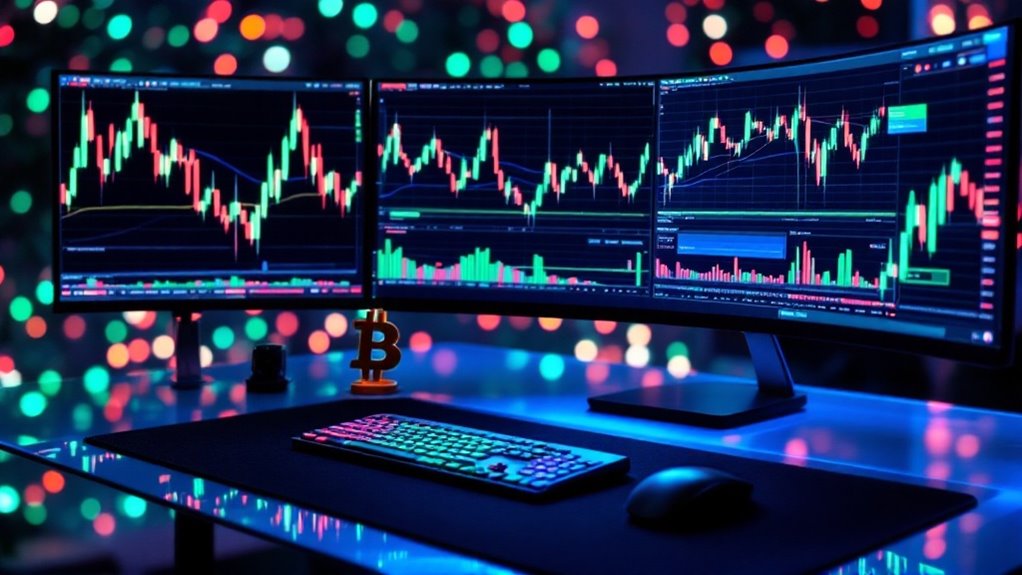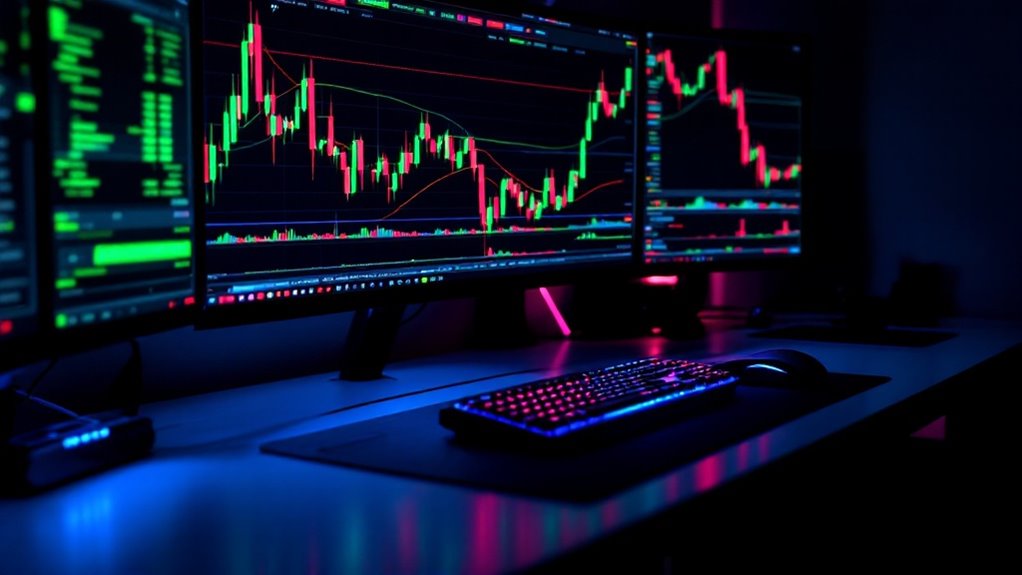Cryptocurrency trading offers diverse paths, from the adrenaline-pumping world of day trading to the zen-like patience of HODLing. Day traders dance with rapid price movements, while long-term holders weather market storms with stoic resolve. Between these extremes, swing traders capture larger market waves, arbitrage seekers exploit exchange differences, and scalpers chase micro-profits with laser focus. Each strategy demands its own blend of skills, time commitment, and emotional fortitude – a trading spectrum where fortune favors those who know themselves best.

Crypto Trading Strategies
How do successful crypto traders navigate the volatile waves of digital asset markets? Like skilled surfers reading ocean patterns, they employ diverse strategies to ride the cryptocurrency tide.
Some embrace the adrenaline rush of day trading, glued to their screens as they chase profits in the market's smallest ripples. These traders dance with danger, opening and closing positions faster than a barista can brew their morning coffee. Drawing from historical data, they analyze past price movements to predict potential market behavior.
Others take a more zen-like approach through the HODL strategy, a demonstration of how even typos can become trading wisdom. These patient investors view their crypto holdings like fine wine – better with age. While day traders chase minutes, HODLers think in years, finding peace amid market storms and letting compound growth work its magic. Understanding market sentiment helps these long-term holders maintain conviction during volatile periods.
Between these extremes lies swing trading, a middle path that captures larger market movements without requiring constant vigilance. These traders are like skilled photographers, waiting for the perfect moment to capture price swings that unfold over days or weeks. The strategy relies heavily on technical analysis tools to identify optimal entry and exit points.
Meanwhile, arbitrage traders perform a digital age ballet, pirouetting between exchanges to profit from price differences faster than you can say "blockchain."
For those who crave intensity, scalping offers a high-stakes game of micro-gains. These traders are like hummingbirds, darting in and out of positions in seconds, sustained by small but frequent sips of profit. Their success depends on split-second decisions and razor-thin margins.
Behind every strategy lies the foundational pillars of technical and fundamental analysis. Technical analysts are like modern-day fortune tellers, reading charts instead of tea leaves, while fundamental analysts dig deep into project foundations like digital archaeologists.
The most successful traders often blend both approaches, using technical indicators to time their moves while letting fundamental research guide their longer-term vision.
Each strategy carries its own rhythm, risks, and rewards in the crypto dance. Success requires not just choosing the right moves, but matching them to one's personality, risk tolerance, and lifestyle.
In this digital gold rush, there's no one-size-fits-all path to prosperity.
Frequently Asked Questions
How Do I Handle Emotional Stress When Experiencing Significant Crypto Trading Losses?
Managing trading losses requires acknowledging emotions without letting them control decisions. Implementing strict risk management, taking breaks, practicing mindfulness, and seeking support from others helps maintain emotional balance during difficult periods.
What Security Measures Should I Implement to Protect My Crypto Trading Accounts?
Traders should implement hardware wallets, enable two-factor authentication, use secure networks with VPNs, maintain separate trading devices, and follow strict password protocols. Regular security audits and account monitoring are essential safeguards.
Which Crypto Trading Platforms Offer the Lowest Fees and Best Reliability?
Binance offers the lowest fees starting at 0.1%, while Coinbase and Kraken provide superior reliability with regulated services and robust security. MEXC features zero maker fees but less established reputation.
Should I Keep My Crypto Holdings on Exchanges or in Personal Wallets?
A balanced approach is recommended: keep small amounts for active trading on reputable exchanges, while storing larger, long-term holdings in personal wallets. This strategy maximizes security while maintaining trading accessibility when needed.
How Do Cryptocurrency Taxes Work in Different Countries and Jurisdictions?
Cryptocurrency taxation varies globally. Most nations treat crypto as property, applying capital gains or income tax. Rates and policies differ considerably, from Singapore's tax-free approach to Japan's 55% maximum rate on gains.









